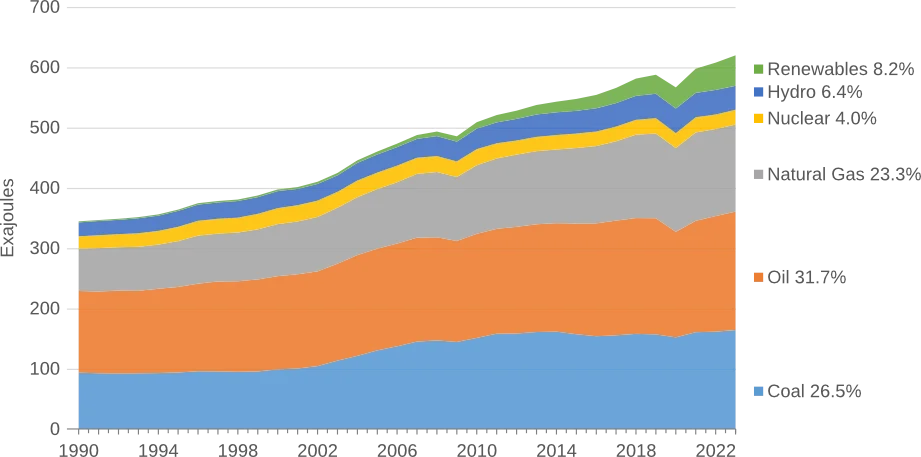Energy Institute releases 2024 Statistical Review of World Energy
21 June 2024
The Energy Institute (EI) released the 73rd edition of the Statistical Review of World Energy—one of the world’s most important sources of energy data, previously published by BP—presenting global energy statistics for 2023.
The general energy trends in 2023 were similar to those in the previous year, showing a continued growth of fossil fuel consumption and CO2 emissions. While renewable energy consumption has seen a steep increase, renewables have not yet replaced any fossil fuels—rather, increasing renewable energy volumes are added on top of growing consumption of fossil fuels.
The report also highlights different energy trends across the globe, with fossil energy consumption peaking in ‘advanced’ economies that experience little or no economic growth, and rising in emerging growth economies such as China and India.
Sone of the key findings of the report are:
- Global primary energy consumption has reached a record absolute high, up 2% on the previous year to 620 Exajoules (EJ).
- Global fossil fuel consumption reached a record high, up 1.5% to 505 EJ (driven by coal up 1.6%, oil up 2% to above 100 million barrels for first time, while gas was flat). As a share of the overall mix, fossil fuels provided 81.5% of global primary energy, marginally down from 81.9% last year.
- Emissions from energy increased by 2%, exceeding 40 Gt of CO2 for the first time.
- Renewable electricity generation, excluding hydro, was up 13% to a record high of 4,748 TWh. This growth, driven almost entirely by wind and solar, accounted for 74% of all net additional electricity generated.
- As a share of primary energy use, renewables (excluding hydro) were at 8.2%, or 14.6% including hydro.

Renewables include solar, wind, geothermal, biomass, and waste
The above primary energy values for non-fossil electric energy are based on input-equivalent energy, defined as the amount of fuel that would be required by a (40.9% efficient) thermal power station to generate the reported electricity output. If non-fossil electricity is compared based on its heat value, the 2023 contribution to the global primary energy mix is 3.7% for renewables (mainly wind and solar), 2.9% for hydro, and 1.8% for nuclear energy.
Primary Energy and CO2—2023 saw a second consecutive record year for global primary energy consumption as it grew by 2%, reaching 620 EJ. Its growth rate was 0.6% above its ten-year average and over 5% above its 2019 pre-Covid level. With demand for natural gas, a relatively low carbon-intensive fossil fuel, remaining flat, the increased use of more carbon-intensive oil and coal meant that energy-related GHG emissions also reached a record high, exceeding 40 Gt CO2e for the very first time.
Oil Production, Refining, and Consumption—Global oil production reached a record level of just over 96 million barrels per day (crude oil + lease condensate + natural gas liquids). The United States remained the largest producer seeing its output grow by over 8%. In contrast, Russia’s output decreased by over 1%. Whilst the USA lost its position as the largest oil refining market by capacity with China reaching 18,484 thousand barrels per day, throughput of refined products from China still lags the USA with a utilization of nearly 82% compared to around 87%.
Consumption of oil exceeded 100 million barrels of oil per day (b/d) for the first time ever. Whilst global gasoline consumption (25 million b/d) was just above its 2019 pre-Covid level, kerosene, although growing strongly (17.5% in 2023), has yet to return to its 2019 peak.
Coal Production and Consumption—Global coal output reached its highest ever level (179 EJ), beating the previous high set in 2022. The Asia Pacific region accounted for nearly 80% of global output with activity concentrated in just four countries: Australia, China, India, and Indonesia. China alone was responsible for just over half of total global production.
Global coal consumption breached 164 EJ for the first time ever. An increase of 1.6% over 2022 was seven times higher than the previous ten-year average growth rate. Whilst China is by far the largest consumer of coal (56% of the world’s total), in 2023 India exceeded the combined consumption of Europe and North America for the first time ever. Coal consumption in both Europe and North America each fell below 10 EJ, their lowest levels since 1965.

Natural Gas—Global gas demand remained stable in 2023 rising by just 1 billion cubic metres (bcm). This was not sufficient to recover the losses seen in 2022 when overall demand dropped by 0.4% (15 bcm). In Europe, natural gas demand fell by 7% (34 bcm) in 2023, down to its lowest level since 1994. Similarly, gas production in the region declined by around 7% driven by decreases in its top producing countries, Norway, UK, and the Netherlands. Gas demand in the Asia Pacific region grew nearly 2%, driven by China and India’s 7% growth increases.
Electricity—Global electricity generation increased by 2.5% in 2023 to reach a record level of 29,925 TWh. Recording a growth rate that was 25% faster than total global primary energy consumption suggests that the world’s energy system is increasingly electrifying. Whilst electricity demand in Asia Pacific and the Middle East increased by around 5%, demand in both Europe and North America fell by 2.4% and 1% respectively. Coal retained its position as the dominant fuel for power generation with fossil fuels overall forming 60% of global electricity generation. Renewables share of total power generation rose from 14.4 to 15.9%. The combined share of renewables and hydro increased from 29.2% to 30.0%.
Source: Energy Institute